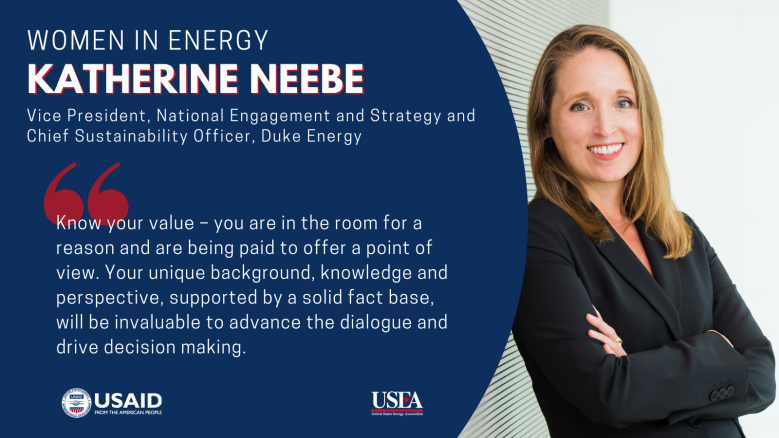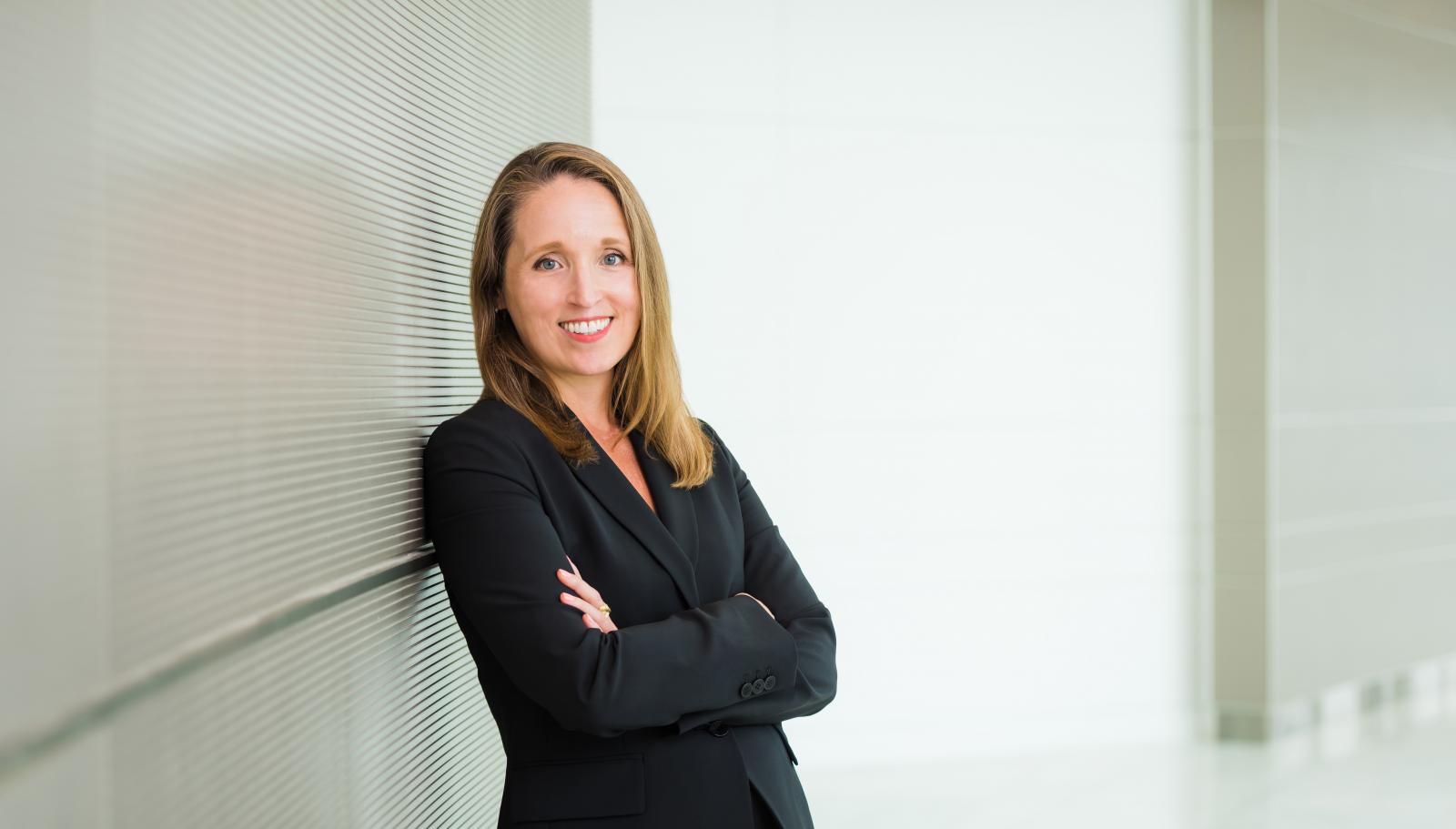
Women In Energy: Katherine Neebe
The Women in Energy series is a joint project between USEA and USAID that was developed out of USEA’s Engendering Utilities Partnership, a program funded by USAID to improve gender policies and gender outcomes at their respective organizations.

Every month we feature a woman who has shown exemplary leadership. The women highlighted come from diverse backgrounds and roles, and they bring with them a unique perspective to gender equality within the energy sector.
Katherine Neebe serves as vice president of national engagement and strategy and chief sustainability officer for Duke Energy. She also serves as president of the Duke Energy Foundation. In these capacities, she leads Duke Energy’s stakeholder engagement efforts to develop solutions to meet customer needs for continued reliable and affordable energy – while simultaneously working to achieve the company’s goal of net-zero carbon emissions by 2050.1. How have both your education and career path led you to where you are now?
I believe that business exists to serve society; business can create extraordinary value for its stakeholders by meaningfully addressing societal challenges, whether those are environmental or social. And this belief has been a “north star” guiding my career for 20 plus years.
I am incredibly fortunate to have had the opportunity to work with The Coca-Cola Company and Walmart and, now, Duke Energy to help accelerate positive impact and deliver shared value. Each of these companies is thoughtfully executing sustainability strategies and gave me the professional platform to address thorny issues such as climate change, freshwater conservation, economic mobility and human trafficking. There are few things I love more than working with large companies, at scale, to try to solve for business and societal challenges.
I also owe a debt to my education, both my liberal arts undergraduate degree from Colorado College, which provided an important foundation for critical thinking, as well as my MBA from the Darden School at the University of Virginia where the case study method coupled with an emphasis on ethics enabled me to learn not only the basics of business but also how to apply those concepts to challenging real world situations.
Each of these experiences helped me to grow and to see an issue from new perspectives while navigating across different systems – all of which has been invaluable.
2. What obstacles have you experienced as a woman pursuing an education and career in the energy industry? What obstacles do women vying for leadership spots face in this sector?
As I am relatively new to the energy industry, I can better speak to my experience in the ESG/sustainability sector, which tends to benefit from good representation of extraordinary leaders, many of whom are women. Here’s what I’ve personally found to be helpful:
- Know your value – you are in the room for a reason and are being paid to offer a point of view. Your unique background, knowledge and perspective, supported by a solid fact base, will be invaluable to advance the dialogue and drive decision making. Know this and embrace it.
- Speak with authority – it’s not enough to say the right thing at the right time, you also must convey confidence (and sometimes a little humor helps). Focus on message delivery as well as a confident tone and body language. These are things within your control that you can practice and get right.
- Everyone is a critic – you cannot please everyone all the time. As women, sometimes our critics fail us for being “too” [insert almost any word]. Rather than listen to (or worse, internalize) those perspectives, find a very short list of trusted advisors to provide you with insight, wisdom and candid feedback.
- Lift up others – as women, we rise when we celebrate the successes of those women who came before us, are beside us and are coming behind us. It’s invaluable to offer a kind word as well as important moments such as mentorships, leadership opportunities, growth projects, speaking engagements, etc. to each other.
3. Technology is transforming the traditional utility business model into a more modern interactive grid. Some utilities view this transformation as an opportunity to focus on innovation and diversity, which research has shown to drive better business performance. How is your organization attracting, retaining, and promoting more women into senior management positions to respond to this industry transformation? Is company data on this publicly available?
Increasing the percentage of underrepresented employee groups, specifically females and race/ethnic minorities, is a Duke Energy priority. We are on a journey to increase diversity and strengthen our culture of inclusion. We believe transparency is an important part of our journey and we are striving to meet aspirational goals for diversity and inclusion progress. In fact, we are one of the few companies in our industry that publicly discloses detailed diversity data.
We have a focus on increasing the overall representation of females and race/ethnicity in the workforce to 25% and 20%, respectively. That’s a start, but not an end point. We know much more work is needed to turn actions into results.
Some of those actions include:
- Constantly evaluating practices across the hiring life cycle – from how we attract/recruit a diverse pool of applicants to how we interview and hire.
- Partnering with the military, community colleges, Historically Black Colleges and Universities and other organizations to attract and recruit diverse talent pools. In fact, we have a dedicated sourcing team in place to seek out diverse talent.
- Ensuring qualified diverse candidates are presented on interview slates, hiring managers are coached on unconscious bias and in many functions diverse interview panels screen candidates in the interview process.
- Monitoring steps within the hiring life cycle with a lens toward diversity.
However, hiring is only one component of increasing the diversity of our workforce. Within that ecosystem is to ensure employees feel that they are having an equitable and inclusive experience – or in simple terms, feel like they belong at the company.
With regard to women in leadership, over the past two years, we’ve increased the percent of racial/ethnic Chief Officers (e.g., CFO, CLO) from 19% to 26%; and increased the percentage of female Chief Officers from 27% to 30%. Vice presidents and senior level leaders comprise 27% female representation and 18.5% race/ethnic representation.
We are intentional and committed to strengthen our culture of inclusion and help define the value diversity and inclusion brings to our company. We know there is a lot more to do on this journey.
4. What changes in the sector at large do you think have launched more women into leadership positions?
I believe we’re seeing data that companies outperform their peers when they have a diverse and inclusive corporate culture. This has helped shift the conversation and the accountability from a “nice to do” to a “must do.”
And I would also point to the recent increase of women in leadership roles within the Fortune 500 over the past few years. This has greatly contributed to all sectors doing a better job to foster cultures of inclusion and belonging; it’s about representation. When people see someone they can identify with in a leadership role it signals to them there is opportunity for them as well.
5. What are some untapped actions the energy and electricity sector could focus on to accelerate change, increase diversity, and foster a better gender balance in the boardroom?
First, Duke Energy makes diversity a priority for the boardroom, including a diversity of skills and experiences, as well as diversity across gender, racial and ethnic diversity. Approximately 38% of our Board identifies as diverse across gender, racial and ethnic dimensions.
Second, and more broadly, diversity must be a priority within a company and leaders need to be accountable for progress. For this to be effective, companies need to establish a culture of inclusion, collect data, and transparently share progress.
Third, and this is a small step everyone can take, is to ensure that industry events, such as conferences, visibly reflect diverse leaders in keynotes and panel discussions. As a related point, panel discussions should consider a moderator with a diverse background but, more importantly, include a diverse slate of discussants.

